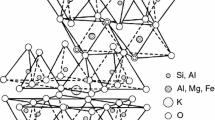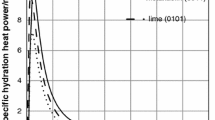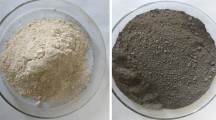Abstract
Temperature dependencies of the DC conductivity of mixtures of kaolin and quartz were measured in the temperature range of 20–1200 °C. During heating, several processes take place in the sample—release of the physically bound water (PBW), dehydroxylation of kaolinite, the α → β transition of quartz, and the creation of Al–Si spinel. These processes were studied using differential thermal analysis, thermogravimetry, thermodilatometry, and DC conductivity measurement. At temperatures < 200 °C, H+ and OH− ions are the dominant charge carriers in the DC conductivity due to the release and dissociation of PBW. After the release of PBW, and up to the start of dehydroxylation (~ 500 °C), the DC conductivity is dominated by the transport of Na+ and K+ ions. During dehydroxylation, OH− ions, which are released from the kaolinite lattice, contribute to the DC conductivity. However, the association of OH− ions with mobile alkali metal ions into neutral complexes, as well as depletion of OH− source, results in a deceleration of the increase in the DC conductivity at 500 °C. After the dehydroxylation is completed, alkali metal ions become again the dominant charge carriers. At temperatures above the dehydroxylation region, the DC conductivity slightly decreases with the increasing quartz content. A narrow peak of the DC conductivity observed at 960 °C can be linked to the motion of Al3+ cations into new sites as the metakaolinite collapses. The DC conductivity of different mixtures did not differ significantly. Quartz and grog have lower conductivities than kaolin. Thus, the conduction was determined by the kaolin matrix (60 mass%).






Similar content being viewed by others
References
Liebermann J. About the important correlation between microstructure properties and product quality of strength-stressed high-voltage insulators [Über den wichtigen zusammenhang von gefügeeigenschaften und produktqualität bei festigkeitsbeonspruchten hochsponnungsisolo. Keram Z. 2002;54:858–61.
Liebermann J. Avoiding quartz in alumina porcelain for high-voltage insulators, Part 2. Am Ceram Soc Bull. 2001;80:43–8.
Dal Bó M, Cantavella V, Sanchéz E, Gilabert FA, Boschi AO, Hotza D. An estimate of quartz content and particle size in porcelain tiles from young’s modulus measurements. Ceram Int. 2016;43:2233–8.
Selli NT, Tunali A. Role of the quartz particles on stain resistance of the polished porcelain tiles. Acta Phys Pol, A. 2014;125:506–8.
Oliveira APND, Vilches ES, Soler VC, Villegas FAG. Relationship between Young’s modulus and temperature in porcelain tiles. J Eur Ceram Soc. 2012;32:2853–8.
Hlaváč J. Technology of silicates. Praha: SNTL; 1981.
Knapek M, Húlan T, Minárik P, Dobroň P, Stubňa I, Stráská J, et al. Study of microcracking in illite-based ceramics during firing. J Eur Ceram Soc. 2016;36:221–6.
Chmelík F, Trník A, Štubňa I, Pešička J. Creation of microcracks in porcelain during firing. J Eur Ceram Soc. 2011;31:2205–9.
Hanykýř V, Havrda J, Trávníček Z. Specialized technology of ceramics II. Praha: VŠCHT; 1989.
Hanykýř V, Kutzendörfer J. Technology of ceramics. Praha: Silikátový svaz; 2008.
Pospíšil Z, Koller A. Fine ceramics: introduction and basics of technology. Praha: SNTL; 1981.
Pytlík P, Sokolář R. Building ceramics—technology, properties and application. Brno: Akademické nakladatelství CERM, s.r.o; 2002.
Yousefi E, Majidi B. Effects of free quartz on mechanical behaviour of kaolinite based geopolymers. Mater Technol. 2011;26:96–9.
Bleaney BI, Bleaney B. Electricity and magnetism. 3rd ed. London: Oxford University Press; 1976.
Halpren A, Erlbach E. Schaum’s outline of beginning physics II. New York: McGraw-Hill Education; 1998.
Štubňa I, Trnovcová V, Vozár L, Csáki Š. Uncertainty of the measurement of DC conductivity of ceramics at elevated temperatures. J Electr Eng. 2015;66:34–9.
Blumenthal RN, Seitz MA. Electrical conductivity in ceramics and glass. In: Tallan NM, editor. Experimental Tech. New York: M. Dekker; 1974.
Podoba R, Trník A, Podobník Ľ. Upgrading of TGA/DTA analyzer derivatograph. Építőanyag. 2012;64:28–9.
Ptáček P, Frajkorová F, Šoukal F, Opravil T. Kinetics and mechanism of three stages of thermal transformation of kaolinite to metakaolinite. Powder Technol. 2014;264:439–45.
Štubňa I, Varga G, Trník A. Investigation of kaolinite dehydroxylations is still interesting. Epa J Silic Based Compos Mater. 2006;58:6–9.
Ptáček P, Šoukal F, Opravil T, Nosková M, Havlica J, Brandštetr J. The kinetics of Al–Si spinel phase crystallization from calcined kaolin. J Solid State Chem. 2010;183:2565–9.
Frost RL, Vassallo AM. The dehydroxylation of the kaolinite clay minerals using infrared emission spectroscopy. Clays Clay Miner. 1996;44:635–51.
Hosieni KR, Howald RA, Scanlon MW. Thermodynamics of the lambda transition and the equation of state of quartz. Am Miner. 1985;70:782–93.
Prjanishnikov VP. System of silica. Leningrad: Strojizdat; 1971.
Podoba R, Štubňa I, Trnovcová V, Trník A. Temperature dependence of DC electrical conductivity of kaolin. J Therm Anal Calorim. 2014;118:597–601.
Wang D, Li H, Yi L, Matsuzaki T, Yoshino T. Anisotropy of synthetic quartz electrical conductivity at high pressure and temperature. J Geophys Res. 2010;115:B09211.
Trnovcová V, Podoba R, Štubňa I. DC conductivity of kaolin-based ceramics in the temperature range 20–600 & #xB0;C. Epitoanyag. 2012;2012:46–9.
Acknowledgements
This work was supported by the Constantine the Philosopher University grant agency [UGA VII/17/2018]. Authors are indebted to the ceramic plant PPC Insulators Čab (Slovakia) for the supply of kaolin.
Author information
Authors and Affiliations
Corresponding author
Additional information
Publisher's Note
Springer Nature remains neutral with regard to jurisdictional claims in published maps and institutional affiliations.
Rights and permissions
About this article
Cite this article
Ondruška, J., Csáki, Š., Štubňa, I. et al. Investigation of kaolin–quartz mixtures during heating using thermodilatometry and DC thermoconductometry. J Therm Anal Calorim 139, 833–838 (2020). https://doi.org/10.1007/s10973-019-08476-2
Received:
Accepted:
Published:
Issue Date:
DOI: https://doi.org/10.1007/s10973-019-08476-2




